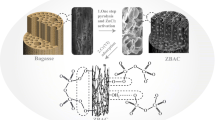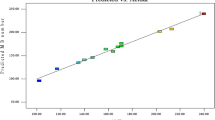Abstract
Adsorption via activated carbon has been testified as an effective way for removing high molecular weight refractory organic compounds from old landfill leachate which is hard to be treated biologically. The present work reveals the preparation and optimization of sugarcane bagasse-based activated carbon (SCAC) by microwave-induced KOH activation for the adsorptive treatment of organic and inorganic contaminants from the mature anaerobic landfill leachate using response surface methodology technique. The effects of variable parameters in SCAC preparation including activation power, activation time and KOH impregnation were studied. Based on the central composite design, the quadratic model was employed in order to correlate the effect of variable parameters in SCAC preparation on adsorptive removal of pollutants. The achieved removal efficiencies of color, COD and ammonia were 97.83, 88.14 and 47.25 %, based on optimum conditions of SCAC at 550 W of activation power, 7 min of activation time and 1.55 of impregnation ratios. The experimental results showed the capability of SCAC prepared via microwave-induced KOH activation in the treatment of stabilized landfill leachate.





Similar content being viewed by others
References
Abu Amr SS, Aziz HA, Adlan MN (2013) Optimization of stabilized leachate treatment using ozone/persulfate in the advanced oxidation process. Waste Manag 33(6):1434–1441
Abu Amr SS, Aziz HA, Bashir MJK (2014) Application of response surface methodology (RSM) for optimization of semi-aerobic landfill leachate treatment using ozone. Appl Water Sci 4:231–239
Adinata D, Wan Daud WMA, Aroua MK (2007) Preparation and characterization of activated carbon from palm shell by chemical activation with K2CO3. Bioresour Technol 98:145–149
Alslaibi TM, Abustan I, Ahmad MA, Foul AA (2013) A review: production of Activated Carbon from agricultural byproduct via conventional and microwave heating. J Chem Technol Biotechnol 88:1183–1190
APHA, WPCF, AWWA (2005) Standard methods for the examination of water and wastewater, 21st edn. American Public Health Association (APHA), Washington
Aziz SQ, Aziz HA, Yusoff MS, Bashir MJK, Umar M (2010) Leachate characterization in semi-aerobic and anaerobic sanitary landfills: a comparative study. J Environ Manag 91:2608–2614
Azmi NB, Bashir MJK, Sethupathi S, Lim JW, Ng CA (2015) Stabilized landfill leachate treatment by sugarcane bagasse derived activated carbon for removal of color, COD and NH3-N—Optimization of preparation conditions by RSM. J Environ Chem Eng 3:1287–1294
Bashir MJK, Aziz HA, Yusoff MS, Aziz SQ (2012) Color and chemical oxygen demand removal from mature semi-aerobic landfill leachate using anion exchange resin: an equilibrium and kinetic study. Environ Eng Sci 29:297–305
Bashir MJK, Aziz HA, Abu Amr SS, Sethupati S, Ng CA, Lim JW (2014) The competency of various applied strategies in treating tropical municipal landfill leachate. Desalination Water Treat 54:2382–2395
Basta AH, Pierro V, El-Saied H, Celzard A (2009) 2-steps KOH activation of rice straw: an efficient method for preparing high performance activated carbons. Bioresour Technol 100:3941–3947
Bhatnagar A, Hogland W, Marques M, Sillanpaa M (2013) An overview of the modification methods of activated carbon for its water treatment. Chem Eng J 219:499–511
Dastyar W, Amani T, Elyasi Sh (2015) Investigation of affecting parameters on treating high-strength compost leachate in a hybrid EGSB and fixed-bed reactor followed by electrocoagulation–flotation process. Process Saf Environ Prot 95:1–11
Foo KY, Hameed BH (2012) Microwave-assisted preparation and adsorption performance of activated carbon from biodiesel industry solid reside: influence of operational parameters. Bioresour Technol 103:398–404
Foo KY, Lee LK, Hameed BH (2013) Preparation of activated carbon from sugarcane bagasse by microwave assisted activation for the remediation of semi-aerobic landfill leachate. Bioresour Technol 134:166–172
Halim AA, Aziz HA, Johari MAM, Ariffin KS, Bashir MJK (2012) Semi aerobic Landfill Leachate Treatment Using Carbon-Minerals Composite Adsorbent. Environ Eng Sci 29:306–312
Hesas RH, Wan Daud WMA, Sahu JN, Arami-Niya A (2013) The effects of a microwave heating method on the production of activated carbon from agricultural waste: a review. J Anal Appl Pyrolysis 100:1–11
Hoareau W, Wanderson GT, Siegmund B, Castelllan A, Frollini E (2004) Sugarcane bagasse and curaua lignins oxidized by chlorine dioxide and react with furfuryl alcohol: characterization and stability. Polym Degrad Stab 86:567–576
Karacan F, Ozden U, Karacan S (2007) Optimization of manufacturing condition for activated carbon from Turkish lignite by chemical activation using response surface methodology. Appl Therm Eng 27:1212–1218
Kin NK, Aziz HA, Mojiri A (2014) Initial Characterization of Semi-aerobic Landfill Leachate Based On Its Biodegradation. Int J Sci Res Environ Sci 2:107–112
Li W, Zhang LB, Peng JH, Li N, Zhu XY (2008) Preparation of high surface area activated carbons from tobacco stems with K2CO3 activation using microwave radiation. Ind Crops Prod 27:341–347
McKee DW (1983) Mechanism of alkali metal catalyzed gasification of carbon. Fule 62:170–175
MHLG—Ministry of Housing and Local Government (2011) Sanitary landfill annual report. Malaysia Government
Mohamed AR, Mohammadi M, Darzi GN (2010) Prepartion of carbon molecular sieve from lignocellulosic biomass: a review. Renew Sustain Energy Rev 14:1591–1599
Mojiri A, Aziz HA, Aziz SQ (2014) Trends in physical-chemical methods for landfill leachate treatment. Int J Sci Res Environ Sci 1:16–25
Naik S, Goud VV, Rout PK, Jacobson K, Dalai AK (2010) Characterization of Canadian biomass for alternative renewable biofuel. Renew Energy 35:1624–1631
Othman E, Yusoff MS, Aziz HA, Adlan MN, Bashir MJK, Hung YT (2010) The effectiveness of silica sand in semi-aerobic stabilized landfill leachate treatment. Water 2:904–915
Renou J, Givaudan G, Poulain S, Dirassouyan F, Moulin P (2008) Landfill leachate treatment: review and opportunity. J Hazard Mater 150:468–493
Saad SA, Isa KM, Bahari R (2010) chemically modified sugarcane bagasse as a potentially low-cost biosorbent for dye removal. Desalination 264:123–128
Saw SK, Sarkhel G, Choudry A (2011) Surface modification of coir fiber involving oxidation of lignin followed by reaction with furfuryl alcohol: characterization and Stability. Appl Surf Sci 257:3762–3769
Shehzad A, Bashir MJK, Sethupathi S, Jun-Wei L (2015) An overview of heavily polluted landfill leachate treatment using food waste as an alternative and renewable source of activated carbon. Process Saf Environ Prot 98:309–318
Shehzad A, Bashir MJK, Sethupathi S, Jun-Wei L (2016) Simultaneous removal of organic and inorganic pollutants from landfill leachate using sea mango derived activated carbon via microwave induced activation. Int J Chem React Eng. doi:10.1515/ijcre-2015-0145
Tan IAW, Ahmad AL, Hameed BH (2008) Optimization of preparation conditions for activated carbons from coconut husk using response surface methodology. Chem Eng J 137:462–470
Tonghua WST, Liang C (2009) Preparation and characterization of activated carbon from wood via microwave-induced ZnCl2 activation. Carbon 47:1880–1883
Xin-hui D, Srinivasakannan C, Jin-hui P, Li-bo Z, Zheng-yong Z (2011) Preparation of activated carbon from Jatropha hull which microwave heating: optimization using response surface methodology. Fuel Process Technol 92:394–400
Yao P (2013) Perspectives on technology for landfill leachate treatment. DOI.org/, Arabian J Chem. doi:10.1016/j.arabjc.2013.09.03
Zhang QQ, Tian BH, Zhang X, Ghulan A, Fang CR, He R (2013) Investigation on characteristics of leachate and concentrated leachate in three landfill leachate treatment plants. Waste Manag 33(11):2277–2286
Author information
Authors and Affiliations
Corresponding author
Rights and permissions
About this article
Cite this article
Azmi, N.B., Bashir, M.J.K., Sethupathi, S. et al. Optimization of preparation conditions of sugarcane bagasse activated carbon via microwave-induced KOH activation for stabilized landfill leachate remediation. Environ Earth Sci 75, 902 (2016). https://doi.org/10.1007/s12665-016-5698-y
Received:
Accepted:
Published:
DOI: https://doi.org/10.1007/s12665-016-5698-y




